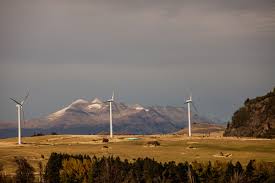Chile’s High-Flying Wind Plan
Washington, D.C., October 30, 2013 — The evidence that the South American coast country of Chile is going heavily for wind power is evident at every major port, from Arica in the desert north to Puerto Montt in the Patagonian temperate rainforest in the south. That’s my observation from a three-week trip by sea down the west coal of South America, including Equador, Peru, and Chile.
Traveling at night over the ocean, running counter to the cold Humboldt Current that wells up from Antarctica and rolls north along the coast, yielding the most productive fishing waters in the world, the Sea Adventurer docked at daybreak for trips and exploration inland. Wind infrastructure was stacked at every dock. The names and logos emblazoned on the gear are instructive of the seriousness of wind in Chile: Enel, Gamesa, Siemens, Vestas.
A new, large wind farm near the copper-mining city of Calama in the Atacama Desert, featuring Enel machines, looks about ready to run. Much of the power will go to the giant copper mine near the city. Calama is also home to ALMA, Atacama Large Millimeter Array, the largest ground-based radio telescope in the world.
And at every dock along our voyage, stacked and threaded among the scores and hundreds of cargo containers that have revolutionized shipping over the past 30 years, were giant turbine blades on protective tubes, curved nacelles, and stubby turbine-generators.
Wind power has always struck me as one of those “horses-for-courses” technologies, well-suited for some situations and not so much for others. It doesn’t really fit well for much of the U.S., in my judgment. But wind makes a lot of sense for Chile, for reasons related to geography, geology, and meteorology.
Chile is a long, slim country, 2,700 miles from north-to-south hugging the western edge of the continent. It is only 150 miles wide at its widest part, the Atacama. The country is dominated by the Pacific to the west and the massive, rugged and still-rising Andes in the east. The winds prevail from East to West (remember, this is the Southern Hemisphere) and the mountains grab the moisture for the Amazon basin and in the Andean glaciers. It is a very windy country from top-to-bottom.
Chile has few indigenous energy resources. It imports natural gas from Argentina, coal from Columbia, and buys oil on the world market. There is some coal – and a small mine-mouth power plant at Lota, a port where we tried to call but were rebuffed by a clown-car of Chilean port authorities who raised all kinds of objections to our touring of their poor city, including a preposterous claim of a coming typhoon, which had our ship’s captain laughing out loud.
Solar can work in the northern part of the country, particularly in the astonishingly sunny and dry Atacama, which receives, according to our guides, less than 0.1mm of annual rainfall. We saw little evidence of solar PV in our days in the Atacama, based in San Pedro de Atacama. But we saw lots of household solar thermal, a remarkably simple technology to heat water.
Solar doesn’t work in Patagonia, which is cool and often overcast. Most Chileans in Patagonia heat their homes with firewood and their water with electricity.
But wind can probably work anywhere in Chile. And it’s not a charity play. Chile is not a poor country. It has large mineral resources, primarily in the Atacama, including copper, nitrates, and, now a great hope for the country, the world’s largest lithium mine on the edge of a brine lake in the middle of the desert, which sits on the altiplano at some 8,000 feet between the coastal mountains and the Andes.
Chile also has valuable agriculture, as the soil, when irrigated by Andean meltwater, is very productive. The country produces fine wine, blueberries timed for the U.S. winter market, artichokes, asparagus. It is also a world-wide leader in salmon farming.
Because of the cold Humboldt current (cold water holds more oxygen than warm water), the water off Chile and Peru is abundant, producing some 10% of the world’s fish production with less than 1% of the world’s water surface. Chile has managed to put its own stamp on one of those Humboldt denizens, which it calls “Chilean Sea Bass.” It’s a tasty fish, and being fished sustainably and the genius was changing its name from its original moniker: Patagonian Tooth Fish.
And Chile has wind. It looks like they are going to use it and, maybe, make it work for them.
